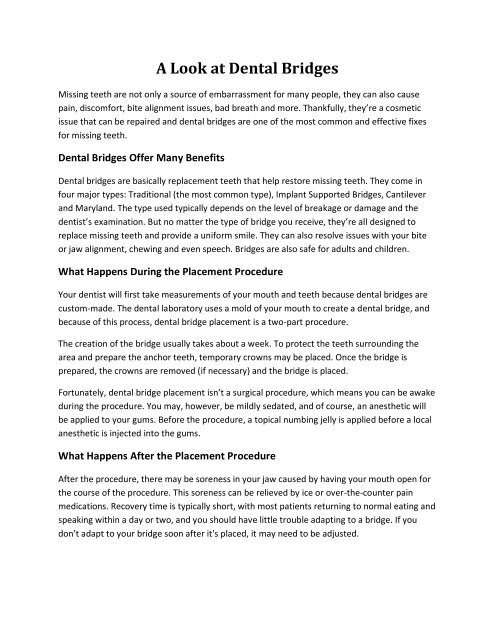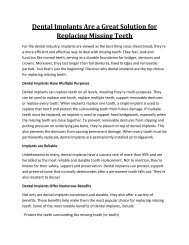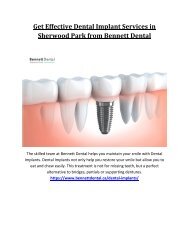A Look at Dental Bridges
Dental bridges are basically replacement teeth that help restore missing teeth. The bridge is composed of a pair of crowns for those teeth found on both sides of a gap.
Dental bridges are basically replacement teeth that help restore missing teeth. The bridge is composed of a pair of crowns for those teeth found on both sides of a gap.
You also want an ePaper? Increase the reach of your titles
YUMPU automatically turns print PDFs into web optimized ePapers that Google loves.
A <strong>Look</strong> <strong>at</strong> <strong>Dental</strong> <strong>Bridges</strong><br />
Missing teeth are not only a source of embarrassment for many people, they can also cause<br />
pain, discomfort, bite alignment issues, bad bre<strong>at</strong>h and more. Thankfully, they’re a cosmetic<br />
issue th<strong>at</strong> can be repaired and dental bridges are one of the most common and effective fixes<br />
for missing teeth.<br />
<strong>Dental</strong> <strong>Bridges</strong> Offer Many Benefits<br />
<strong>Dental</strong> bridges are basically replacement teeth th<strong>at</strong> help restore missing teeth. They come in<br />
four major types: Traditional (the most common type), Implant Supported <strong>Bridges</strong>, Cantilever<br />
and Maryland. The type used typically depends on the level of breakage or damage and the<br />
dentist’s examin<strong>at</strong>ion. But no m<strong>at</strong>ter the type of bridge you receive, they’re all designed to<br />
replace missing teeth and provide a uniform smile. They can also resolve issues with your bite<br />
or jaw alignment, chewing and even speech. <strong>Bridges</strong> are also safe for adults and children.<br />
Wh<strong>at</strong> Happens During the Placement Procedure<br />
Your dentist will first take measurements of your mouth and teeth because dental bridges are<br />
custom-made. The dental labor<strong>at</strong>ory uses a mold of your mouth to cre<strong>at</strong>e a dental bridge, and<br />
because of this process, dental bridge placement is a two-part procedure.<br />
The cre<strong>at</strong>ion of the bridge usually takes about a week. To protect the teeth surrounding the<br />
area and prepare the anchor teeth, temporary crowns may be placed. Once the bridge is<br />
prepared, the crowns are removed (if necessary) and the bridge is placed.<br />
Fortun<strong>at</strong>ely, dental bridge placement isn’t a surgical procedure, which means you can be awake<br />
during the procedure. You may, however, be mildly sed<strong>at</strong>ed, and of course, an anesthetic will<br />
be applied to your gums. Before the procedure, a topical numbing jelly is applied before a local<br />
anesthetic is injected into the gums.<br />
Wh<strong>at</strong> Happens After the Placement Procedure<br />
After the procedure, there may be soreness in your jaw caused by having your mouth open for<br />
the course of the procedure. This soreness can be relieved by ice or over-the-counter pain<br />
medic<strong>at</strong>ions. Recovery time is typically short, with most p<strong>at</strong>ients returning to normal e<strong>at</strong>ing and<br />
speaking within a day or two, and you should have little trouble adapting to a bridge. If you<br />
don’t adapt to your bridge soon after it's placed, it may need to be adjusted.
If you would like to learn more about replacing missing teeth with a bridge, contact us to book<br />
an appointment with a family dentist. Edmonton and area families visit Bennett <strong>Dental</strong> for a<br />
full range of dental services, including bridges.














